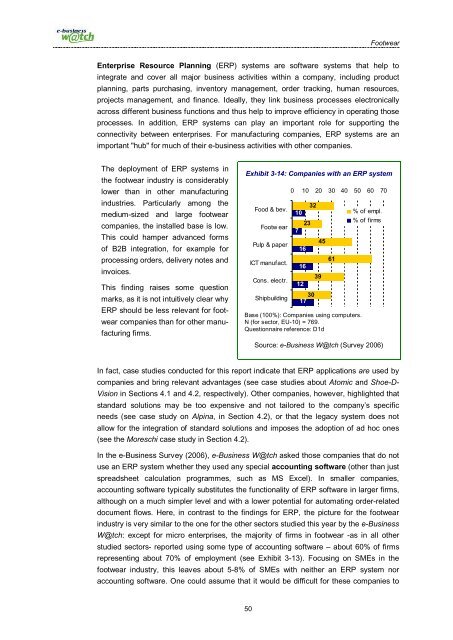Footwear Industry Footwear Industry - empirica
Footwear Industry Footwear Industry - empirica
Footwear Industry Footwear Industry - empirica
Create successful ePaper yourself
Turn your PDF publications into a flip-book with our unique Google optimized e-Paper software.
<strong>Footwear</strong><br />
Enterprise Resource Planning (ERP) systems are software systems that help to<br />
integrate and cover all major business activities within a company, including product<br />
planning, parts purchasing, inventory management, order tracking, human resources,<br />
projects management, and finance. Ideally, they link business processes electronically<br />
across different business functions and thus help to improve efficiency in operating those<br />
processes. In addition, ERP systems can play an important role for supporting the<br />
connectivity between enterprises. For manufacturing companies, ERP systems are an<br />
important "hub" for much of their e-business activities with other companies.<br />
The deployment of ERP systems in<br />
the footwear industry is considerably<br />
lower than in other manufacturing<br />
industries. Particularly among the<br />
medium-sized and large footwear<br />
companies, the installed base is low.<br />
This could hamper advanced forms<br />
of B2B integration, for example for<br />
processing orders, delivery notes and<br />
invoices.<br />
This finding raises some question<br />
marks, as it is not intuitively clear why<br />
ERP should be less relevant for footwear<br />
companies than for other manufacturing<br />
firms.<br />
Exhibit 3-14: Companies with an ERP system<br />
Food & bev.<br />
<strong>Footwear</strong><br />
Pulp & paper<br />
ICT manufact.<br />
Cons. electr.<br />
Shipbuilding<br />
0 10 20 30 40 50 60 70<br />
10<br />
7<br />
16<br />
16<br />
12<br />
23<br />
32<br />
30<br />
17<br />
39<br />
45<br />
61<br />
Base (100%): Companies using computers.<br />
N (for sector, EU-10) = 769.<br />
Questionnaire reference: D1d<br />
% of empl.<br />
% of firms<br />
Source: e-Business W@tch (Survey 2006)<br />
In fact, case studies conducted for this report indicate that ERP applications are used by<br />
companies and bring relevant advantages (see case studies about Atomic and Shoe-D-<br />
Vision in Sections 4.1 and 4.2, respectively). Other companies, however, highlighted that<br />
standard solutions may be too expensive and not tailored to the company’s specific<br />
needs (see case study on Alpina, in Section 4.2), or that the legacy system does not<br />
allow for the integration of standard solutions and imposes the adoption of ad hoc ones<br />
(see the Moreschi case study in Section 4.2).<br />
In the e-Business Survey (2006), e-Business W@tch asked those companies that do not<br />
use an ERP system whether they used any special accounting software (other than just<br />
spreadsheet calculation programmes, such as MS Excel). In smaller companies,<br />
accounting software typically substitutes the functionality of ERP software in larger firms,<br />
although on a much simpler level and with a lower potential for automating order-related<br />
document flows. Here, in contrast to the findings for ERP, the picture for the footwear<br />
industry is very similar to the one for the other sectors studied this year by the e-Business<br />
W@tch: except for micro enterprises, the majority of firms in footwear -as in all other<br />
studied sectors- reported using some type of accounting software – about 60% of firms<br />
representing about 70% of employment (see Exhibit 3-13). Focusing on SMEs in the<br />
footwear industry, this leaves about 5-8% of SMEs with neither an ERP system nor<br />
accounting software. One could assume that it would be difficult for these companies to<br />
50

















